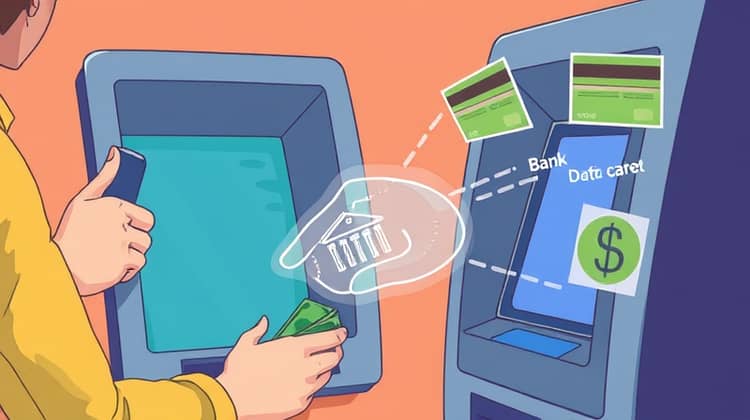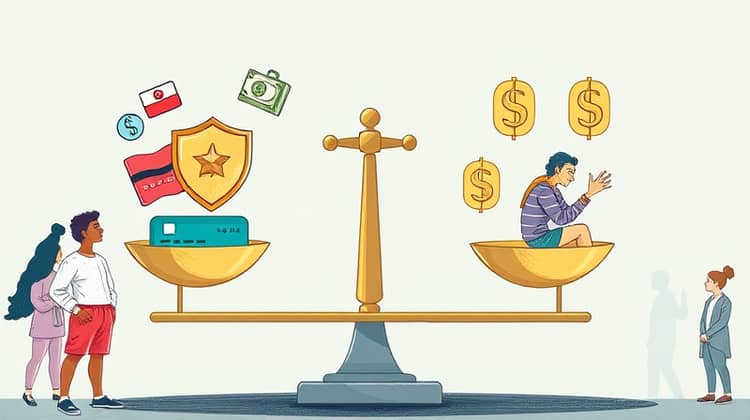Overdraft protection is a financial service that allows bank account holders to make transactions even when their balance is insufficient, preventing the risk of a bounced check or declined debit transaction. This financial cushion can provide peace of mind, particularly in emergencies or unexpected situations. However, it is essential to understand both the benefits and drawbacks of opting for overdraft protection to make an informed decision on whether it is the right choice for your financial management. In this article, we will explore the basics of overdraft protection, its pros and cons, and how to choose the right option for your needs.
The Basics of Overdraft Protection

Overdraft protection comes into play when a bank account holder attempts to withdraw more money than is available in their account. Instead of declining the transaction, the bank temporarily covers the shortfall, allowing the transaction to go through despite the insufficient funds. This service can be linked to a savings account, credit card, or line of credit, from which the required amount is borrowed to cover the transaction. Many banks also offer overdraft protection as an optional service that account holders can choose to enroll in or opt out of at any time.
Understanding how overdraft protection works is crucial. When you opt for this service, your bank may charge you fees for each transaction that exceeds the balance in your account. While overdraft protection may prevent embarrassment or inconvenience at the checkout counter, users should be cautious of the potential financial implications that can arise from its use.
Another vital aspect of overdraft protection is the difference between standard overdraft coverage and overdraft lines of credit. Standard overdraft coverage allows the bank to cover transactions exceeding the account balance, but the account holder may face hefty fees. On the other hand, an overdraft line of credit allows you to borrow money up to a certain limit, typically at a lower interest rate than the standard overdraft fees. Understanding these distinctions can help consumers make better financial decisions.
Pros of Overdraft Protection

Overdraft protection provides several advantages that can benefit account holders in various ways. To start, it offers a safety net for individuals who may not always accurately track their spending or account balances. This coverage can prevent the inconvenience of declined transactions when funds are low or unavailable, allowing for smoother financial management.
Additionally, overdraft protection can have a positive impact on one's credit history when used responsibly. Payments that are made on time can contribute favorably to a credit report, helping to build a positive credit score. Despite potential fees, many individuals find the convenience it offers worth the cost, making it an attractive option for some.
- Avoiding overdraft fees
- Convenience in transactions
- Improved financial management
- Positive credit impact
Overall, the pros of overdraft protection can offer significant benefits to individuals who manage their finances wisely. By taking advantage of this service, account holders can maintain greater control over their finances and avoid potential penalties that arise from insufficient funds incidents.
1. Avoiding Overdraft Fees
One of the primary advantages of overdraft protection is the ability to avoid overdraft fees incurred from bounced checks or declined transactions. These fees can accumulate quickly, leading to significant financial strain for account holders. By having overdraft protection in place, account holders can prevent these fees from piling up, allowing for seamless transactions even when their account balance is lower than expected.
In many cases, banks charge hefty fees ranging from $30 to $40 for each transaction that results in insufficient funds. Frequent overdrafts can quickly lead to substantial costs that could have been avoided altogether. For those relying on a paycheck or regular income, opting for overdraft protection can act as a buffer during lean times and help maintain financial stability when unexpected expenses arise.
Furthermore, overdraft protection does not prevent individuals from monitoring their bank accounts or planning their finances more effectively. Instead, it provides a flexible safety net that can support account holders during moments of financial strain while simultaneously encouraging them to adopt better budgeting practices.
2. Convenience
Another major pro of overdraft protection is the convenience it provides for account holders. Individuals lead busy lives, and often accounting for every transaction is challenging. Overdraft protection ensures that transactions can seamlessly go through without the stress of monitoring daily balances obsessively. Whether it's a last-minute grocery shopping trip or an emergency repair, overdraft protection offers peace of mind.
Additionally, overdraft protection can facilitate a more efficient cash flow management process. For individuals who have irregular income streams or fluctuating expenses, preventing declined transactions can be crucial in maintaining financial commitments and keeping operations at ease. The ability to complete transactions without hesitation can contribute to an improved quality of life for many.
3. Improved Financial Management
Having overdraft protection can lead to improved financial management by prompting account holders to keep better track of their spending. In recognizing that they have a financial cushion available, individuals may feel empowered to manage their budgets more effectively and plan their expenses more strategically. This system can serve as a useful short-term tool for handling emergencies or unpredictable bills.
Moreover, the prospect of overdraft protection can incentivize individuals to develop and maintain healthy financial habits. As they familiarize themselves with the limits and terms of the service, they often take greater care to oversee their transactions, leading to increased awareness of their overall financial situation. This can ultimately pave the way for better financial decision-making in the long run.
4. Positive Credit Impact
Another benefit of overdraft protection is its potential positive impact on an individual's credit history. Using overdraft protection responsibly means that payments are made on time, which ensures minimal risk of incurring late fees or negative marks on the credit report. Consequently, maintaining a good credit score becomes easier for those who utilize this service wisely.
Having a solid credit score can open doors to better financing opportunities in the future. Higher credit scores often lead to lower interest rates on loans and credit cards. With overdraft protection contributing positively to credit health, individuals may find it easier to secure favorable financing arrangements, improving overall financial well-being as they navigate future financial commitments.
Cons of Overdraft Protection

While overdraft protection offers various benefits, there are numerous drawbacks to consider before enrolling in this service. One of the primary concerns is the potential for high costs associated with overdraft fees and interest rates. Banks often charge hefty fees each time a transaction exceeds the account balance, contributing to financial strain.
Moreover, countless individuals fall into a cycle of dependence on overdraft services, leading to poor spending habits and even more significant financial problems down the road. Understanding the potential downsides of overdraft protection can foster better financial decisions and sensible budgeting practices moving forward.
- High interest rates
- Encourages overspending
- Complexity and confusion
- May not cover all transactions
- Potential for negative credit impact
In summary, some of the cons of overdraft protection can lead individuals down a challenging financial path if not approached mindfully. Understanding these drawbacks can help consumers gauge their financial health and make informed decisions about their banking services.
1. High Interest Rates
One significant downside of overdraft protection is the potentially high-interest rates associated with this service. Although overdraft fees may be charged, if the overdraft exceeds the account limit and requires borrowing from a line of credit, interest rates can often range from 15% to 25% or higher—especially if the overdraft remains unpaid for an extended period. This can lead to an accumulating debt burden, further complicating financial obligations for individuals already experiencing challenges managing their accounts.
Unlike traditional loans or credit cards, the fees and interest rates attached to overdraft protection can be less transparent, leading many account holders to underestimate the costs associated with repeatedly relying on this option. Over time, as balances continue to accrue interest, the total amount owed can snowball, making it challenging to repay and leaving individuals in a precarious financial position.
As a result, it is crucial for individuals to remain mindful of the costs associated with overdraft protection. Awareness and diligent management of overdraft use can prevent individuals from falling deeper into debt and limit reliance on this financial service.
2. Encourages Overspending
While overdraft protection can provide a financial cushion, it can also inadvertently encourage overspending habits. Knowing that overdraft protection is available might lead individuals to be less vigilant about managing their spending, as they may feel confident that they can always make a purchase without worrying about account balances. This trend can lead to irregular spending patterns and a general disconnection from the financial realities individuals face.
Furthermore, this false sense of security may create a recurring cycle where consumers rely on overdraft protection too often, leading to further financial instability. Awareness of the impact of this habit is essential for individuals aiming to maintain sustainable spending practices and long-term financial health.
3. Complexity and Confusion
Overdraft protection can often be complicated and confusing, both in terms of understanding the terms and conditions and navigating through the various options that banks offer. Many institutions do not provide clear explanations about the differences between overdraft protection options, leading customers to make choices without fully grasping the implications. Without proper understanding, individuals may inadvertently end up paying more than expected due to fees and interest rates.
Additionally, some banks may have different policies regarding transactions covered by overdraft protection. For instance, not all transactions may be eligible, which can lead to unexpected declined purchases despite having overdraft protection. A lack of clarity around which transactions are covered can create confusion and anxiety among consumers, particularly when unexpected costs arise.
4. May Not Cover All Transactions
Another significant disadvantage to consider is that overdraft protection may not cover all transactions, leaving account holders vulnerable to declined payments or overdraft fees if certain transactions are not protected. For example, some banks may choose to limit overdraft coverage to specific types of transactions, such as checks or debit card purchases, leaving other transactions, like recurring payments or electronic transfers, outside of the protection umbrella.
This lack of comprehensive coverage can lead to frustration and confusion for individuals who assumed they had a safety net in place. For those who rely on overdraft protection for recurrent expenses, like housing or utilities, a missed payment could have dire consequences. As such, consumers should seek to clarify the terms of their overdraft protection policy and ensure that the transactions they consider essential will be adequately covered.
5. Potential for Negative Credit Impact
While overdraft protection can provide short-term relief for many, it can also adversely affect one's credit score in the long run if not used responsibly. For example, repeated overdrafts can lead to an accumulation of debt, which may result in missed payments, contributing to a negative credit profile. Additionally, banks may report consistent reliance on overdraft services to credit bureaus, impacting the overall credit picture. This shift can hinder an individual's ability to secure future loans or make larger purchases due to high-interest rates.
Therefore, individuals should take a proactive approach to managing their finances and understand how overdraft protection could potentially impact their credit in both the short and long term. Awareness of these potential risks can maintain healthy credit scores while still utilizing necessary financial services.
How to Choose the Right Overdraft Protection

Selecting the best overdraft protection option for your financial needs requires careful consideration. When contemplating this service, it’s important to assess your personal financial habits and determine whether overdraft protection aligns with your financial goals. Start by analyzing your spending habits and account balance history to evaluate how often you may rely on overdraft protection, and consequently, how much you may need.
Another helpful step is to explore different banks and evaluate their overdraft protection options. This includes understanding the fees associated with overdrafts, the interest rates on lines of credit, and what transactions are eligible for protection. Additionally, some financial institutions may offer complimentary services that can assist account holders in managing their finances more effectively, such as mobile alerts about balance thresholds or spending limits.
Finally, consider your broader financial circumstances. If you find yourself in a situation where you might frequently rely on overdraft protection, it may be wise to seek budgeting tools or financial counseling to enhance your overall financial health, rather than solely relying on overdraft services.
- Assess personal financial habits
- Explore different bank options
- Understand associated fees and interest rates
By evaluating these factors, individuals can make an informed decision about the right overdraft protection that aligns with their financial situation and goals. Making the right choice can empower consumers and enhance their financial management capabilities.
Conclusion

In conclusion, overdraft protection can be a valuable financial resource for many people, offering both pros and cons that individuals must weigh carefully. The added convenience, ability to avoid costly overdraft fees, and potential positive impacts on credit can make this option appealing. However, it is equally important to acknowledge the drawbacks, such as high-interest rates, potential for overspending, and possible negative credit consequences if mismanaged.
Ultimately, thoroughly understanding how overdraft protection works and assessing your unique financial circumstances are crucial in making the right decision. Everyone's financial situation is different, and what works for one individual may not be suitable for another. The balance between maintaining financial security and promoting healthy spending habits is vital in solidifying a sustainable financial future.
To effectively utilize overdraft protection, one must remain vigilant about its usage and be proactive in managing finances. Budgeting, monitoring spending, and being aware of associated fees can help individuals avoid falling into the pitfalls that come with excessive reliance on this service.














